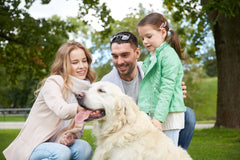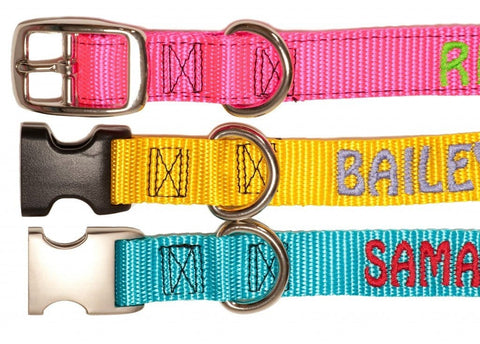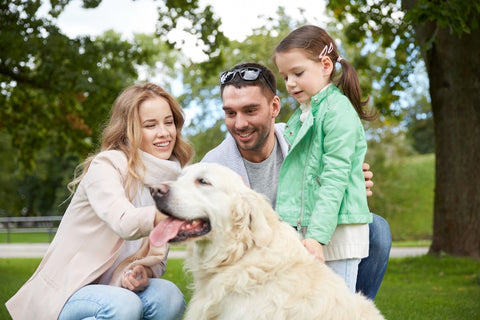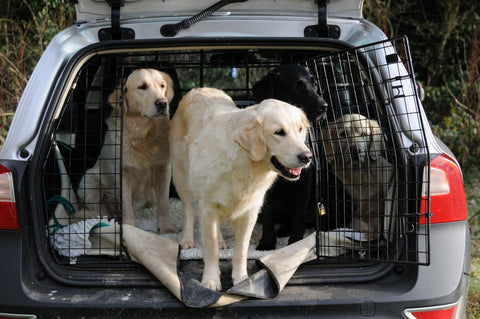Our pets are like family. In fact, they ARE Family. We love our cats and dogs, even the times they try and drive us crazy. That’s one of their charms, isn't it? We love them because they love us, unconditionally. We forgive them because they forgive us, unconditionally.
Whether we are in the neighborhood, in the park, at a local coffee shop, we take them along. If that isn’t family, what is? Our lives wouldn’t be the same without our pets, and we would do anything to keep them happy and safe. Here are a few simple pet safety tips to help keep your furry friend safe and sound under your loving care.

#1: Escape Proof Your Home
Equip the inside of your home to prevent your pet from escaping. Make sure the windows and doors are secure. Consider investing in gates and childproof clasps as well.
#2: Know Pet First Aid and Keep a First Aid Kit Readily Available
Keeping a first aid kit for our animals is essential in the event of an accident. A pet first aid kit typically includes bandages, medications, ointments, eye care, cold packs, splints, tick and spider treatment to name just a few.
#3: Always License Your Pet
If your pet should ever become lost or stolen, his pet license is an added level protection. This almost goes without saying. Besides, it’s the law.
#4: Remember to Spay or Neuter Your Pet
Help to control the unwanted animal population. Spayed or neutered animals are less likely to run away, due to their lack of biological instincts.
#5: Is Your Contact Information Correct?
Make sure your current phone number is on your pet’s ID tag or on their custom dog collar. If there is ever an emergency, it’s important that someone can contact you.

#6: Keep a Small Kennel with Food Stored In Your Car
Unwanted circumstances can strike at any time and you’ll need to gather up your furry family members, so have some food and a kennel ready. You may also consider keeping this as part of a "Found Pet Toolbox."
#7: Are You Prepared for Your Pet to Go AWOL?
Some pets are afraid of their new environment, and dogs can especially be natural escape artists. The yard should not be a prison, but rather a haven. Make sure his toys are plentiful and spend quality time with him while in the yard. He will grow to feel safe in the yard rather than feel he needs to get away.
#8: Want Extra Protection? Go High Tech
Newer high-tech collars have QR codes embedded chips. When the code is scanned by a smartphone, it displays your contact information and important pet data, such as license and vaccinations. This information is vital for animal control in reuniting pet and owner quickly.
#9: Do You Have Pictures of your Pet?
It’s a great idea to keep current pictures of your pets. They can become invaluable if your pet ever turns up lost and you want to make flyers. Photos can also help prove that the pet belongs to you if they are lost or stolen.

#10: Know the Signs of a Stressed-Out Pet
Typical stress signs include drooling, panting, hiding, pacing, a decreased appetite, abnormal urination or defecation, excessive grooming and dilated pupils.
#11: Keep Your Pet’s Medical Records at the Ready
We all know our own medical history, past surgeries, and current medications. It's vital in case of an emergency. The same goes for our furry friends. High-tech collars can even link to an online profile for your pet and store easily retrievable electronic medical pet information.
#12: Your Pet’s Collar Must Fit Correctly
If your dog is a talented escape artist, use a harness. For cats, consider a breakaway collar. A microchip, in addition to a collar and ID tag, is also important so there is a way to retrieve your information if the collar should fail or come off.
#13: Double-Check Your Pet’s Collar
Sometimes leashes need replacing - especially if your pet likes using it for a chew toy. Examine the clasp and be sure it is operating correctly, and examine the entire leash for malfunctions.
#14: Inspect the ID Tag
Do a periodic check of your pet's ID tag. Is it still legible? If it has a QR code, make sure it can be easily scanned.
#15: ID Tags are Vital
It almost goes without saying, but be sure your pet has an external ID tag, and for super high tech protection, get them micro-chipped. For added protection consider investing in a digital ID tag.

#16: Have Enough Pet Food Ready
This is especially helpful if you live in an area prone to natural disasters, or even the occasional snow day or temporary power outage.
#17: What Would Happen if You Ended Up Incapacitated?
If you should become injured, experience an unexpected illness, or become temporarily incapable of caring for your pet, reach out to others and alert them about your pet and their needs. In fact, have a plan in place even before it happens. A simple wallet card can be a valuable tool for informing anyone who will be caring for your pets.
#18: Obedience Training Can Be Helpful
Even the best and most well-behaved pets can turn up lost or missing. Teaching simple pet obedience commands like “stay,” or "come" can be crucial.
#19: Ensure Your Pet is Traveling Safely
If your animal is riding in the car with you, they should wear a collar and even be in a crate if possible. If a crate isn’t feasible, consider tethering their leash to ensure their limited movement.

#20: Keep Extra Treats and Favorite Toys Available
A favorite snack or toy could play a key role in finding your lost pet or in luring an animal that has run away or is in shock.
#21: Pet Insurance
Just as it can be costly for humans to visit a doctor or clinic, it is the same for our animal friends. Emergency vet visits can be especially expensive. Pet insurance is a viable option for helping with these types of emergencies. Some insurance plans even allow for a free annual pet check-up.
#22: Be Ready for a Disaster
Don't get caught leaving your pet stranded in the event of an earthquake, fire, or hurricane. Emergency rescue stickers are critical for alerting a rescue worker that you have a pet in need of help or rescue.

#23: Help Your Pet Learn to Discover Their New Environment
Spend the necessary time introducing your pet to a new neighborhood. Take them for walks and let them enjoy their new surroundings. Let the neighbors meet your dog or cat so they can watch and keep an eye out for their well-being.
#24: Stay With Your Pet Outside
You may want to take your dog for a walk and run a few errands all on the same outing, however, you really shouldn't. If the errands require you to leave your pet outside, leave them at home. If you leave your dog unattended outside, it actually increases the chance of your them being pet-napped or escaping.

#25: What’s the Plan if Your Pet is Missing?
Do you have a plan in place if your pet is ever discovered missing? There are many pet owners who keep a “recovery toolbox” which includes helpful instructions for searching for lost pets. This toolbox can also include health records which can be shared on the internet. This is handy if your pet is a flight risk.
#26: Inspect Your Fence
Fences can't always prevent a pet from escaping. Try monitoring the behavior of your pet and determine if they are at risk of getting free. Maybe your pet jumps fences, digs under them, or both? If your pet is a jumper, increasing the height of the fence might be the solution, and eliminating stacked items along the fence line will discourage your pet from escaping. If your pet likes to dig, make sure the base of the yard is tight and secure. A simple boulder will block the area for a digging pet.

#27: Your Pet Would Prefer You Have a Mobile Phone
Having your mobile phone handy in any emergency situation is helpful. This is also really important in case of an emergency for your pet or when finding a lost animal.
#28: Microchips are Your Friend
Micro-chipping has saved millions of lost animals from being exterminated each year. When an animal is brought to a shelter or animal hospital, scanning for a microchip is the first order of business. It’s better to be safe than sorry.
#29: Keep an Extra Collar on Hand and in Your Car
A frightened animal can oftentimes escape from a collar, and an additional pet collar is helpful if you happen to find a homeless animal.
#30: Know the Veterinarians, Shelters, and Animal Rescue Groups in Your Area
Remember to keep a good list of helpful information on hand such as local veterinarians, shelters, and animal rescue groups in a place that is easy to locate. You can even put the list in your car. You never know, this might come in handy if you lose your pet or if you find a lost animal.
Its our job to make sure that our pets are safe and that we have made it a priority to provide the things for them to maintain their safety. The very best tip that I can provide to you is to make sure your pet wears a collar anytime that they are outside. The best collars in my opinion are customized dog collars that include all of the essential information about your pet including your phone number so that if your pet is found without out you, someone will know how to contact you.

It doesn’t matter what our pets do or if they misbehave on occasion. Our pets are family, for sure. Now when Fido is curled up at your feet, you can be assured it’s because he feels safe in the environment you have created for him and he’ll appreciate the loving care you provide.
